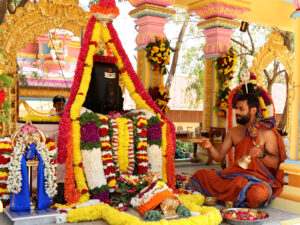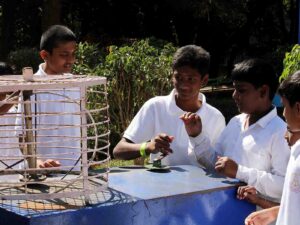The grand event celebrating the 99th birthday of beloved Bhagawan Sri Sathya Sai Baba was a divine spectacle, highlighted by the Maha Kumbabhishekam of the newly-consecrated temple at Sri Sathya Sai Vaatsalyam. This temple, enshrined with the sacred idols of Sri Sarvaantaraatmeshwara Swami, Sri Vaatsalyambika Devi, and Sri Guru Guha Swami, stands as a beacon of spiritual light, dedicated to the selfless elevation of all beings.
The three-day celebrations unfolded with a series of profound and auspicious rituals. The first day commenced with the sacred Guru Ganapathy Puja, Mahasankalpam, Ankurarpanam, and Vaastu Puja, each ceremony imbuing the atmosphere with spiritual energy. On the second day, powerful rituals continued with the Gana Homam, Navagraha Homam, Mandala Puja, and the Sudarshana Homam—each performed with unwavering devotion and profound reverence.
The final day, commemorating Bhagawan’s 99th birthday, witnessed the pinnacle of spiritual ceremonies—the grand Prana Pratishtha and Maha Kumbabhishekam. These sacred rituals were beautifully enhanced by the active participation of children from Sri Sathya Sai Gnyana Dayini and women from Sri Sathya Sai Shubha Dayini, embodying a collective spirit of devotion.
The celebrations concluded with the felicitation of all those involved in the temple’s construction and ceremonies, and a soul-stirring violin concert by Kumari C.S. Chinmayi, which added a transcendent musical grace to this momentous spiritual occasion.
The Divine Unfolding of Pujas and Sacred Ceremonies
The sacred journey towards the Maha Kumbhabhishekam began in the early morning hours of the first day of the three-day celebration, with divine rituals of Guru Ganapathy Puja, Mahasankalpam, and Ankurarpanam filling the atmosphere with spiritual vibrations at the Sadashivam hall.
These auspicious ceremonies set the tone for the day, creating an aura of divine grace and anticipation.



As evening settled in, the Vaastu Homam infused the surroundings with sanctity, while a deeply moving moment unfolded during the Gau Puja. A mother cow, tenderly nuzzling her 10-day-old calf, became a living symbol of divine, unconditional love, reflecting the purest form of maternal affection. Following this, sacred water from the Pancha Bhoota Sthalas of Lord Shiva and Aru Padai Veedu of Lord Subramanya was collected in preparation for the Kalasha Puja for the deities.






The second day of celebrations at Sri Sathya Sai Vaatsalyam emerged as a profound spiritual experience, weaving together ancient rituals and heartfelt devotion. Morning ceremonies commenced with the sacred Gana Homam and Navagraha Homam.



As twilight fell, the Mandala Puja and Sudarshana Homam commenced. The evening rituals filled the space with a sense of sanctity, drawing participants into a deeper spiritual experience. The ceremonies elevated hearts and minds, creating an atmosphere of anticipation for the upcoming Maha Kumbhabhishekam, a promising moment of ultimate spiritual consecration.



The third day of the celebrations, commemorating Bhagawan Sri Sathya Sai Baba’s 99th birthday, was a transcendent moment at Sri Sathya Sai Vaatsalyam. The day dawned with the profound Prana Pratishtha and Maha Kumbhabhishekam ceremonies, honouring the sublime idols of Sri Sarvaantaraatmeshwara Swami, Sri Vaatsalyambika Devi, and Sri Guru Guha Swami.
Hallowed vedic chants heralded the morning, culminating in the majestic unveiling of the divine idols. The inaugural Abhishekam followed, with the Kalasha Abhishekam particularly meaningful to the women of Sri Sathya Sai Shubha Dayini, who participated with heartfelt devotion.








As energetic bhajans and the melodious strains of Thavil and Nadaswaram filled the air, the Alankaram of the idols was performed behind the curtains, building anticipation. When the curtains were drawn, the sight of the lifelike idols, radiating divine grace and spiritual aura, left everyone present deeply moved. The Maha Kumbabhishekam culminated with the Homa Purnahuti, followed by a heartfelt felicitation of those involved in the temple’s construction and the inauguration pujas. The ceremony concluded with the Maha Mangala Aarti and the distribution of Maha Prasadam to all.

The Temple Significance
The temple at Sri Sathya Sai Vaatsalyam is not just a physical structure, but a profound manifestation of divine love, spiritual unity, and timeless wisdom.
This sacred temple is home to three divine manifestations, each representing a vital aspect of the spiritual journey.
Sri Sarvaantaraatmeshwara Swami, the Supreme Lord in His most complete and universal form, embodying both the Pancha Bhoota (five elements) and Pancha Kritya (five divine acts), signifying creation, preservation, dissolution, veiling, and grace. The unique Shiva Lingam in the temple serves as a powerful reminder that all beings are equal in the eyes of the Divine and that we are all interconnected through the same divine consciousness. The temple breaks the barriers of caste, gender, creed, and economic status, emphasizing the universal nature of spirituality.

Sri Vaatsalyambika Devi, the Divine Mother, is a radiant embodiment of maternal love, protection, grace, and compassion.

Sri Guru Guha Swami, the Supreme Teacher, represents Lord Subramanya in his role as the illuminator of divine wisdom. Known for revealing the profound mysteries of the Pranava Mantra (Om) to Lord Shiva, he stands as the embodiment of spiritual knowledge and guidance.

Together, these three deities—Sri Sarvaantaraatmeshwara Swami, Sri Vaatsalyambika Devi, and Sri Guru Guha Swami—create a sacred space where divine wisdom, love, and protection converge, guiding devotees towards spiritual growth and inner peace.
Evening Celebrations of the 99th Birthday of Bhagawan Sri Sathya Sai Baba
The evening celebrations was filled with love and gratitude, as cakes were cut, songs were sung, and children presented beautiful cards in reverence to Bhagawan Sri Sathya Sai Baba.






The highlight of the evening was a special violin concert by Kumari C. S. Chinmayi, accompanied by Vidwan Kumbakonam Swaminathan on Mridangam and Vidwan Harish Chandra on Kanjira. C.S. Chinmayi is a talented young violinist trained in the Lalgudi Bani under her father and guru, Sri C.N. Srinivasamurthy, a disciple of the legendary Violin Maestro Padmabhushan Sri Lalgudi Jayaraman. The melodious music, with evocative songs such as ‘Kanakanaruchira’, ‘Jagadodhaarana’, and ‘Maand Thillana’, elevated the spirits of all present, bringing the three-day celebration to a lively and soulful conclusion.




True to Bhagawan’s teaching of “from love, with love, for love,” the entire celebration was a manifestation of divine love. All those who participated in this spiritual odyssey were filled with immense gratitude, having been part of a truly transformative experience.









